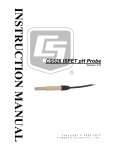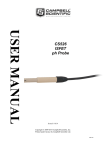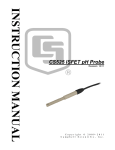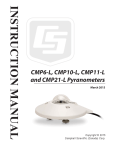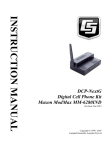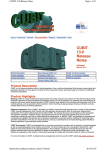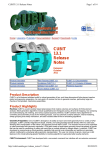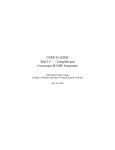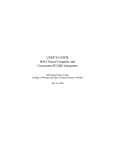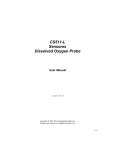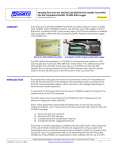Download Campbell CS526 Product manual
Transcript
CS526 ISFET pH Probe 2/12 C o p y r i g h t © 2 0 0 9 - 2 0 1 2 C a m p b e l l S c i e n t i f i c , I n c . Warranty The CS526 ISFET pH Probe is warranted for six (6) months subject to this limited warranty: “PRODUCTS MANUFACTURED BY CAMPBELL SCIENTIFIC, INC. are warranted by Campbell Scientific, Inc. (“Campbell”) to be free from defects in materials and workmanship under normal use and service for twelve (12) months from date of shipment unless otherwise specified in the corresponding Campbell pricelist or product manual. Products not manufactured, but that are re-sold by Campbell, are warranted only to the limits extended by the original manufacturer. Batteries, fine-wire thermocouples, desiccant, and other consumables have no warranty. Campbell's obligation under this warranty is limited to repairing or replacing (at Campbell's option) defective products, which shall be the sole and exclusive remedy under this warranty. The customer shall assume all costs of removing, reinstalling, and shipping defective products to Campbell. Campbell will return such products by surface carrier prepaid within the continental United States of America. To all other locations, Campbell will return such products best way CIP (Port of Entry) INCOTERM® 2010, prepaid. This warranty shall not apply to any products which have been subjected to modification, misuse, neglect, improper service, accidents of nature, or shipping damage. This warranty is in lieu of all other warranties, expressed or implied. The warranty for installation services performed by Campbell such as programming to customer specifications, electrical connections to products manufactured by Campbell, and product specific training, is part of Campbell’s product warranty. CAMPBELL EXPRESSLY DISCLAIMS AND EXCLUDES ANY IMPLIED WARRANTIES OF MERCHANTABILITY OR FITNESS FOR A PARTICULAR PURPOSE. Campbell is not liable for any special, indirect, incidental, and/or consequential damages.” Assistance Products may not be returned without prior authorization. The following contact information is for US and international customers residing in countries served by Campbell Scientific, Inc. directly. Affiliate companies handle repairs for customers within their territories. Please visit www.campbellsci.com to determine which Campbell Scientific company serves your country. To obtain a Returned Materials Authorization (RMA), contact CAMPBELL SCIENTIFIC, INC., phone (435) 227-2342. After an applications engineer determines the nature of the problem, an RMA number will be issued. Please write this number clearly on the outside of the shipping container. Campbell Scientific's shipping address is: CAMPBELL SCIENTIFIC, INC. RMA#_____ 815 West 1800 North Logan, Utah 84321-1784 For all returns, the customer must fill out a "Statement of Product Cleanliness and Decontamination" form and comply with the requirements specified in it. The form is available from our web site at www.campbellsci.com/repair. A completed form must be either emailed to [email protected] or faxed to (435) 227-9579. Campbell Scientific is unable to process any returns until we receive this form. If the form is not received within three days of product receipt or is incomplete, the product will be returned to the customer at the customer's expense. Campbell Scientific reserves the right to refuse service on products that were exposed to contaminants that may cause health or safety concerns for our employees. CS526 Table of Contents PDF viewers: These page numbers refer to the printed version of this document. Use the PDF reader bookmarks tab for links to specific sections. 1. Introduction..................................................................1 2. Cautionary Statements................................................1 3. Initial Inspection ..........................................................1 4. Quickstart .....................................................................2 5. Overview.......................................................................3 6. Specifications ..............................................................3 7. Installation and Wiring ................................................4 7.1 Preparation for Use...................................................................................4 7.2 Wiring.......................................................................................................4 8. Programming ...............................................................4 8.1 Get Data Command ..................................................................................4 8.2 CRBasic Programming .............................................................................5 8.2.1 Instruction Sequence.......................................................................5 8.2.2 Instruction Descriptions ..................................................................6 8.2.2.1 SerialOpen() Instruction........................................................6 8.2.2.2 SerialOut Instruction .............................................................6 8.2.2.3 SerialIn Instruction................................................................6 8.2.2.4 SplitStr Instruction ................................................................7 8.2.3 Example Program............................................................................7 8.2.4 Programming for Calibration ..........................................................7 9. Calibration ....................................................................7 10. Troubleshooting ........................................................8 11. Maintenance ...............................................................9 i CS526 Table of Contents Appendix A. Calibration................................................................ A-1 Figure 11-1. Tip of the CS526 Probe ...................................................................... 10 Tables 7-1. 8-1. 8-2. 9-1. CR800, CR850, CR1000, and CR3000 Wiring...................................... 4 Get Data Command and Response ......................................................... 5 Instruction Sequence............................................................................... 5 Calibration Standards ............................................................................. 8 ii CS526 ISFET pH Probe 1. Introduction The CS526 ISFET pH Probe measures pH from 0 to 14 in aqueous or semisolid solutions. It outputs TTL serial data that is read by compatible dataloggers (see Section 6 Specifications). Before using the CS526, please study • Section 2. Cautionary Statements • Section 3. Initial Inspection • Section 4. Quickstart More detailed instructions for operation, troubleshooting, and maintenance are available in the remaining sections. 2. Cautionary Statements • Maximum input voltage is 5 Vdc. Incorrect wiring may cause loss of performance and irreversible damage. • To prevent scratching the sensor chip when cleaning, first soak the sensor in soapy water, then gently scrub with a toothbrush (see Section 11. Maintenance). Most scratches occur when hard particles are rubbed on the chip surface. Scratches cause irreversible damage to the probe. • The CS526 is rugged, but it should be handled as a precision scientific instrument. • The CS526 has no user-serviceable parts. Any attempt to disassemble the device will void the six-month warranty. • Care should be taken when opening the shipping package to not damage or cut the cable jacket. If damage to the cable is suspected, consult with a Campbell Scientific applications engineer. 3. Initial Inspection Upon receipt of the CS526, inspect the packaging and contents for damage. File damage claims with the shipping company. The model number and cable length are printed on a label at the connection end of the cable. Check this information against the shipping documents to ensure the correct product and cable length are received. 1 CS526 ISFET pH Probe 4. Quickstart For complete installation, programming, and calibration information, see Sections 7 through 9. The CS526 is shipped dry. Before the probe can be calibrated, it must be soaked in 7 pH buffer solution for 15 minutes. Follow the calibration procedure outlined in Appendix A. Unlike many glass-bulb type pH sensors, the CS526 ISFET pH probe can be installed without regard to orientation. Connect the CS526 to the datalogger according to the following table. Be sure to connect Red to the 5V channel. Wire Color Datalogger Connection Red (Caution! 5 Vdc Max!) 5V Black G White Control Port (Tx) Green Control Port (Rx) Clear G Program the datalogger as follows. 'CR1000 Series Datalogger 'Declare variable for PH measurement in mV Public pHmV 'Declare variables for serial input from sensor Dim rawstring As String * 20, pHDigit(2) 'Main Program BeginProg 'Set up one of the datalogger's ports for serial communication SerialOpen ( Com1,2400,16,0,41) 'Establish program scan rate of 60 seconds Scan (60,Sec,0,0) 'Send get data command to CS526 SerialOut (Com1,"1M1!"&CHR(13),"",0,0) 'Set up COM1 to receive incoming serial data. 'Set timeout to maximum 200mS SerialIn (rawstring,Com1,20,0,20) 'Split out numeric mV value for PH from string input SplitStr (pHDigit(),rawstring,"String",2,0) pHmV = pHDigit(2) NextScan EndProg 2 CS526 ISFET pH Probe 5. Overview The submersible CS526 is designed to reliably provide accurate temperature compensated pH measurements. The pH-sensitive element is SENTRON's Ion Sensitive Field Effect Transistor (ISFET) semi-conductor, which includes a silver / silver chloride - potassium chloride reference system. This technology is the most significant breakthrough in pH testing in half a century and is the most powerful pH testing technology available today. The CS526 is suitable for demanding applications in laboratory and field. The ISFET performs well in solutions with high solids, moderately aggressive chemicals, and biological materials. Clogging and junction contaminating conditions are well tolerated. See Section 11 Maintenance for cleaning procedures. CS526 electronics are embedded in durable PEEK material, which makes up the sensor body. The absence of a glass electrode eliminates the potential hazard of broken glass. The ISFET design considerably reduces the number of acidic or alkaline errors in extreme pH conditions. 6. Specifications Features • Safety — the ISFET with durable PEEK material can be used safely in applications where broken glass is a hazard to the user. • Intelligent electronics — the CS526 combines the latest developments in ISFET pH sensing technology with state-of-the-art signal processing. This allows for accurate, fast and reliable results. • Quality — designed and manufactured under stringent quality control conditions in an ISO 9001 environment. Each sensor is individually tested to the most demanding testing protocols, and the electronics comply fully directives and with EMC standard IEC61326:2005. with Compatibility: CR800 / 850, CR1000, CR3000 dataloggers Measurement Range: Accuracy: 24 hr drift: 1 to 14 pH ±0.2 pH with 2 point calibration < 0.15 pH (after 15 min soak in pH 7 at 25°C) Operating Temperature: Water Pressure: 10° to 40°C 0 to 700 kPa (0 to 101.5 psi) Storage Temperature: 20° to 30°C Power Requirement Source: Load: 5 Vdc 15 mA maximum Output: TTL logic, 2400 bps 8 data bits, no parity, 1 stop bit 3 CS526 ISFET pH Probe Maximum Cable Length: 100 m (328 ft) Cable Type: Three-twisted pair, 24 awg cable with Santoprene® jacket Sensor Material: PEEK Weight w/10 ft Cable: Dimensions Length: Diameter: 318 g (11.2 oz) 102 mm (4 in) 16 mm (0.63 in) Certifications: ISO 9001 compliant EMC standard IEC61326:2005 7. Installation and Wiring 7.1 Preparation for Use The CS526 is shipped dry. Before the probe can be calibrated, soak it in 7 pH buffer solution for 15 minutes. Unlike many glass-bulb type pH sensors, the CS526 ISFET pH probe can be installed without regard to orientation. 7.2 Wiring TABLE 7-1. CR800, CR850, CR1000, and CR3000 Wiring CAUTION Wire Color Wire Label/Function Datalogger Connections Red (see following caution) Power 5V 5V Black Ground G White Signal #1 (Tx) Control Port (Tx) Green Signal #2 (Rx) Control Port (Rx) Clear Shield G This probe must be connected to the datalogger’s 5V terminal (not 12V). Connecting to a higher voltage will damage the probe beyond repair. 8. Programming 8.1 Get Data Command The datalogger needs to send a “get data” serial command to the CS526 to get the pH data. This command is sent to the CS526 via the SerialOut() CRBasic 4 CS526 ISFET pH Probe instruction (see Section 8.2.2.2). Table 8-1 shows the “get data” command and its response. TABLE 8-1. Get Data Command and Response Command Response aMn!<CR> a<value><CR><LF> Where: a = probe address (factory default is 1) n = a single dummy character (typically use 1) Where: a = probe address (factory default is 1) <value> = the probe’s reading for pH (in millivolts). 8.2 CRBasic Programming 8.2.1 Instruction Sequence A sequence of CRBasic instructions are used to measure the sensor. Table 8-2 shows the instruction sequence. Information about the instructions is provided in Section 8.2.2 and an example program is provided in Section 8.2.3. TABLE 8-2. Instruction Sequence Instruction Function SerialOpen() Set up a datalogger port for serial communication (see Section 8.2.2.1) Scan() Establish a scan rate SerialOut() Send “get data” command to the CS526. See Section 8.1 and 8.2.2.2 for more information. SerialIn() Set up the COM port to receive the incoming serial data (see Section 8.2.2.3). Please note that in the beginning of the CRBasic program, the variable used in the SerialIn instruction needs to be declared as an ASCII string format. SplitStr() NOTE Split out numeric millivolt value for pH from the input string. Probe output is “Counts”. A corrected multiplier and offset are required to provide an output in pH units (see Appendix A). 5 CS526 ISFET pH Probe 8.2.2 Instruction Descriptions 8.2.2.1 SerialOpen() Instruction The SerialOpen() instruction has the following syntax: SerialOpen(ComPort,BaudRate,Format,TXDelay,BufferSize) ComPort — the datalogger COM port to which the probe is connected. BaudRate — choose 2400 Format — choose 16, which is TTL Logic; No parity, one stop bit, 8 data bits; No error checking TXDelay — enter 0 BufferSize — enter at least twice the number of maximum expected characters + 1, which is 41. 8.2.2.2 SerialOut Instruction The SerialOut() instruction has the following syntax: SerialOut(ComPort,OutString,WaitString,NumberTries,TimeOut) ComPort — the datalogger COM port in which the probe is connected. OutString — use "1M1!"+CHR(13) for the OutString when the default probe address of 1 is used. WaitString — enter the null (“”) WaitString to tell the datalogger to wait for the echo of each character in the OutString NumberTries — enter 0 TimeOut — specifies the time, in 0.01 seconds, that the datalogger should wait for the WaitString or echo of each character in the OutString (0 is used in the example program). 8.2.2.3 SerialIn Instruction The SerialIn() instruction has the following syntax: SerialIn(Dest,ComPort,TimeOut,TerminationChar,MaxNumChars) Dest — specifies the variable in which the incoming data will be stored. Please note that in the beginning of the CRBasic program, this variable needs to be declared as ASCII string format (see example program in Section 8.2.3) ComPort — the datalogger COM port in which the probe is connected. TimeOut — 20 should be adequate, which gives a 200 ms maximum delay time. The TimeOut parameter is used to specify the amount of time, in 0.01 seconds, that the datalogger should wait before proceeding to the next instruction. TerminationChar — enter 0 MaxNumChars — 20 should be adequate (specify the maximum number of characters to expect per input) 6 CS526 ISFET pH Probe 8.2.2.4 SplitStr Instruction The SplitStr() instruction has the following syntax: SplitStr(SplitResult,SearchString,FilterString,NumSplit,SplitOption) SplitResult — an array in which the split string will be stored. SearchString — the string on which this instruction will operate. This will be the variable entered for the Dest parameter for the SerialIn instruction (see above). FilterString — enter “String” (this value will be ignored because of the SplitOption that will be used). NumSplit — enter 2 SplitOption — enter 0. This splits out numeric values. 8.2.3 Example Program The following is a CR1000 program that measures the CS526. This program assumes the CS526 is connected to COM1 (C1 / TX and C2 / RX) on the CR1000. 'CR1000 Series Datalogger 'Declare variable for PH measurement in mV Public pHCount 'Declare variables for serial input from sensor Dim rawstring As String * 20, pHDigit(2) 'Main Program BeginProg 'Set up one of the datalogger's ports for serial communication SerialOpen ( Com1,2400,16,0,41) 'Establish program scan rate of 60 seconds Scan (60,Sec,0,0) 'Send get data command to CS526 SerialOut (Com1,"1M1!"&CHR(13),"",0,0) 'Set up CR1000 COM1 to receive incoming serial data. 'Set timeout to maximum 200 ms SerialIn (rawstring,Com1,20,0,20) 'Split out numeric mV value for pH from string input SplitStr (pHDigit(),rawstring,"String",2,0) pHCount = pHDigit(2) NextScan EndProg 8.2.4 Programming for Calibration To output in pH units instead of millivolts, enter the offset and multiplier into the datalogger program. Simple program instructions can be used to make the required periodic calibration easier. See Appendix A for an example program. 9. Calibration Calibration should be carried out according to the detailed procedure outlined in Appendix A. The calibration should utilize two or more pH standards, listed in Table 9-1, which are available from Campbell Scientific. 7 CS526 ISFET pH Probe TABLE 9-1. Calibration Standards pH CSI Part Number 4 25587 7 25586 10 25588 Frequency of calibration depends on the level of accuracy required and the coating / fouling nature of the measured samples. 10. Troubleshooting The most common causes for erroneous pH data include: • poor sensor connections to the datalogger • damaged cables • scratched chip Problem: Output signal is at its maximum value. Possible reason: o Probe is not in fluid. o Chip is polluted. o Diaphragm is polluted. o Chip is scratched. Suggestion: o Put probe in fluid. o Clean probe using soapy water method. o Probe cannot be fixed if chip is scratched. Problem: Probe response is very slow. Possible reason: o Diaphragm is chipped or polluted. Suggestion: o Clean probe with soapy water method. Problem: Probe signal is drifting. Possible reason: o Diaphragm can be dried out. o Chip is scratched. Suggestion: o Soak probe for 10 minutes in saturated KC1 solution (CSI PN 16349). o Probe cannot be fixed. 8 CS526 ISFET pH Probe 11. Maintenance Campbell Scientific recommends that the CS526 be cleaned and calibrated periodically to insure accurate readings. The CS526 has no user-serviceable parts. If the CS526 is not operating properly and requires return to Campbell Scientific, first obtain an RMA (returned material authorization) and fill out the Declaration of Hazardous Material and Decontamination form. This information is available at http://www.campbellsci.com/repair. Cable can be damaged by abrasion, rodents, sharp objects, twisting, crimping or crushing and pulling. Take care during installation and use to avoid cable damage. Contamination on the diaphragm may block the built-in reference electrode, so there will be no electrical contact between the electrode and the ISFET chip. This condition will cause the probe to not function. To prevent this, regular cleaning is recommended. Frequency of cleaning depends on the quality of the water. The best cleaning method is the “soapy water” method: CAUTION 1. Place the tip of the probe in soapy water that is 50° to 60°C and soak for about 5 minutes (see Figure 11-1). 2. Rinse thoroughly with deionized water. 3. If necessary, lightly scrub the tip of the probe with a toothbrush to remove debris (see following caution). 4. Place the probe in saturated KC1 solution (CSI pn 16349) at about 20°C. Keep probe in solution for about 30 minutes. To prevent scratching the chip, a toothbrush should only be used after soaking in soapy water. Most scratches occur when hard particles are rubbed with a toothbrush on the chip surface. This can cause irreversible damage to the probe. 5. Rinse the probe. 6. Calibrate the probe (see Appendix A). 9 CS526 ISFET pH Probe Diaphragm Chip FIGURE 11-1. Tip of the CS526 Probe 10 Appendix A. Calibration This calibration process uses 7 pH and 4 pH buffer solutions. NOTEProtect the sensing chip from UV radiation during calibration. If calibrating in sun or fluorescent light, shield the sensing chip from UV by using dark containers for the buffer solutions. Load the following example CRBasic program into the datalogger. Wire the CS526 to the datalogger according to the following diagram. Wire Color Datalogger Connection Red (Caution! 5 Vdc Max!) 5V Black G White Control Port (Tx) Green Control Port (Rx) Clear G Use the Numeric Display found in the datalogger software PC200W, PC400, LoggerNet, PConnect, or PConnectCE to monitor the measurement in real time. 1. Place the CS526 into a pH 7 buffer solution (CSI pn 25586). 2. Monitor the [pHmV] reading in the Numeric Display and allow it to stabilize. 3. Change the value in [pH7record] to -1. 4. Remove the CS526 from the pH7 buffer solution and rinse with de-ionized water. 5. Blot the CS526 dry with a soft cloth or paper towel. 6. Place the CS526 in a pH 4 buffer solution (CSI pn 25587). 7. Allow the [pHmV] reading to stabilize. 8. Change the value in [pH4record] to -1. 9. Change the value in [pHcal] to -1. 10. The CS526 is now ready to be placed in the solution to be measured. A-1 Appendix A. Calibration Following is a simple example program to facilitate the two point calibration. 'CR1000 Series Datalogger 'Define Variables Public pH, pHCount Public PTemp, batt_volt Public pH4record, pH4Count Public pH7record, pH7Count Public pHcal, pHmult1 Public pHoffset1 Dim rawstring As String * 20, pHDigit(2) 'Define Data Tables DataTable (TenMin,1,-1) DataInterval (0,10,Min,10) Average (1,pH,FP2,False) EndTable 'Main Program BeginProg SerialOpen (Com1,2400,16,0,41) Scan (10,Sec,0,0) PanelTemp (PTemp,250) Battery (batt_volt) SerialOut (Com1,"1M1!"&CHR(13),"",0,0) SerialIn (rawstring,Com1,20,0,20) SplitStr (pHDigit(),rawstring,"String",2,0) pHCount = pHDigit(2) 'Calibration If PH4record = -1 Then pH4Count = pHCount pH4record = 0 EndIf If pH7record = -1 Then pH7Count = pHCount pH7record = 0 EndIf If pHcal = -1 Then pHmult1 = 3/(pH7Count - pH4Count) pHoffset1 = 7 - pHmult1 * pH7Count pHcal = 0 EndIf pH = pHmult1 * pHCount + pHoffset1 CallTable TenMin NextScan EndProg A-2 Campbell Scientific Companies Campbell Scientific, Inc. (CSI) 815 West 1800 North Logan, Utah 84321 UNITED STATES www.campbellsci.com • [email protected] Campbell Scientific Africa Pty. Ltd. (CSAf) PO Box 2450 Somerset West 7129 SOUTH AFRICA www.csafrica.co.za • [email protected] Campbell Scientific Australia Pty. Ltd. (CSA) PO Box 444 Thuringowa Central QLD 4812 AUSTRALIA www.campbellsci.com.au • [email protected] Campbell Scientific do Brazil Ltda. (CSB) Rua Luisa Crapsi Orsi, 15 Butantã CEP: 005543-000 São Paulo SP BRAZIL www.campbellsci.com.br • [email protected] Campbell Scientific Canada Corp. (CSC) 11564 - 149th Street NW Edmonton, Alberta T5M 1W7 CANADA www.campbellsci.ca • [email protected] Campbell Scientific Centro Caribe S.A. (CSCC) 300 N Cementerio, Edificio Breller Santo Domingo, Heredia 40305 COSTA RICA www.campbellsci.cc • [email protected] Campbell Scientific Ltd. (CSL) Campbell Park 80 Hathern Road Shepshed, Loughborough LE12 9GX UNITED KINGDOM www.campbellsci.co.uk • [email protected] Campbell Scientific Ltd. (France) 3 Avenue de la Division Leclerc 92160 ANTONY FRANCE www.campbellsci.fr • [email protected] Campbell Scientific Spain, S. L. Avda. Pompeu Fabra 7-9, local 1 08024 Barcelona SPAIN www.campbellsci.es • [email protected] Please visit www.campbellsci.com to obtain contact information for your local US or International representative.




















